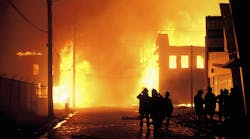An independent analysis of the response to the Sept. 11 attack on the Pentagon released today reveals important lessons for local emergency personnel throughout the nation, Arlington officials said. Arlington, which is home to the Pentagon, was the first responder to the attack and led the 10-day rescue and recovery effort. The FBI assumed command of the crime scene on Sept. 21.
While the After-Action Report commends Arlington, and its many public, private and non-profit partners, for its successful handling of the rescue and recovery efforts, it also points to several challenges and makes recommendations to overcome those challenges in the future.
"The success of the response was due in large part to Arlington's level of preparedness and professional, innovative use of resources," said Grant Peterson of Titan Systems Corporation (TSC), which prepared the report. "Arlington employees throughout the organization from the library system, schools, parks and recreation - hundreds of them from every department - were engaged to provide vital resources quickly and efficiently."
The report was commissioned by Arlington, utilizing a grant from the U.S. Department of Justice.
"As first responders to this terrible act of terrorism, we have a responsibility to share our experiences for the benefit of our regional emergency officials and the rest of America's local leaders," Arlington County Manager Ron Carlee said. "As professionals, we must be able to do an even better job if we have to respond to another mass casualty incident today. Beyond enhancing our own capabilities, we hope this report will help other local governments in their emergency preparedness planning."
The report outlined five primary aspects of the Arlington-led response which contributed to the successful operation and are models for other emergency responders to follow.
Among the best practices are:
· The Incident Commander leadership model, which helped multiple jurisdictions work together effectively with strong central leadership from Incident Commander James H. Schwartz, Arlington Assistant Fire Chief of Operations and Emergency Services and Arlington Fire Chief Edward Plaugher.
· The successful management and integration of numerous mutual-aid assets and outside support, including all levels of government, the military, public service organizations and businesses.
· Adherence to Arlington's Comprehensive Emergency Management Plan (CEMP), first established in 1956, which enabled the quick marshalling of county resources in support of first responders without interfering with tactical operations.
· Deployment of Arlington's Employee Assistance Program (EAP). Already an established program in the county, the EAP was on the scene within three hours of the attack to provide support to first responders, their families and others.
· Prior training related to Weapons of Mass Destruction (WMD). Having long recognized the potential risks for such attacks in the Washington, D.C. area, county officials have led aggressive training exercises related to the threat of terrorism since the 1995 sarin nerve gas attack in Tokyo. They also had extensive training related to Y2K preparedness and helped pioneer a mass medical emergency response system now embraced by more than 100 cities. In addition to describing the best practices of the operation, the After-Action Report also points to five challenges faced by regional emergency officials at the Pentagon which have important relevance to emergency preparedness leaders across the country.
The key challenges of the response included:
· The self-dispatching of organizations, response units and individuals who arrived to help, but without the knowledge of the Incident Command post complicated the command capabilities and increased risks to responders already on the scene.
· Space and communications capabilities at the emergency control center and mobile command unit need expanding to be better prepared for an operation of this magnitude.
· Communication was impaired due to the inability to use cell phones, oversaturated radio channels and lack of interoperability of radios between jurisdictions, a problem the report notes continues to be a nationwide issue.
· Supplies of emergency equipment, medical supplies and critical high-demand items (such as batteries and breathing apparatus) were insufficient for a long-term operation, though other jurisdictions, under the mutual-aid agreement, were able to fill the needs.
· Communications and coordination between EMS control at the incident site and area hospitals receiving injured patients should be strengthened. An incident with more casualties would have seriously strained the system.
In addition to addressing a number of the issues outlined in the After-Action Report, Arlington has created two staff positions to concentrate on reviewing the more than 235 recommendations made in the report regarding overall emergency preparedness and developing an emergency preparedness blueprint that can be used by Arlington and local governments throughout the country.
"It was the vision of outstanding Arlington officials such as Fire Chief Edward Plaugher and Police Chief Edward Flynn that helped Arlington respond successfully to the Pentagon crisis, and their continued leadership and the commitment of other county employees will ensure we continue to refine and improve emergency preparedness," Carlee said.
In preparing the report, TSC reviewed key records, interviewed key first responders and emergency management officials and surveyed hundreds of additional participants from neighboring jurisdictions, federal agencies, the military, public service organizations and the private sector.
Copies of the After-Action Report on the Response to the Sept. 11 Attack on the Pentagon can be obtained in PDF or HTML on Arlington's website.
Home to the Pentagon, Arlington County, VA is located just across the Potomac River from Washington, D.C. While geographically the smallest county in the United States, occupying an area slightly less than 26 square miles, Arlington has 190,000 residents, over 200,000 jobs and millions of tourists each year. Employees report to many government agencies in Arlington and the private companies that support those agencies. The Pentagon alone has a workforce of more than 23,000 military and civilian personnel. In addition, 17% of the county is federal property. Arlington is also home to Ronald Reagan National Airport, the 16th busiest airport in the country. Under the County Manager form of governance, Arlington is a county that acts as a municipality, providing all public services to county residents and businesses.





